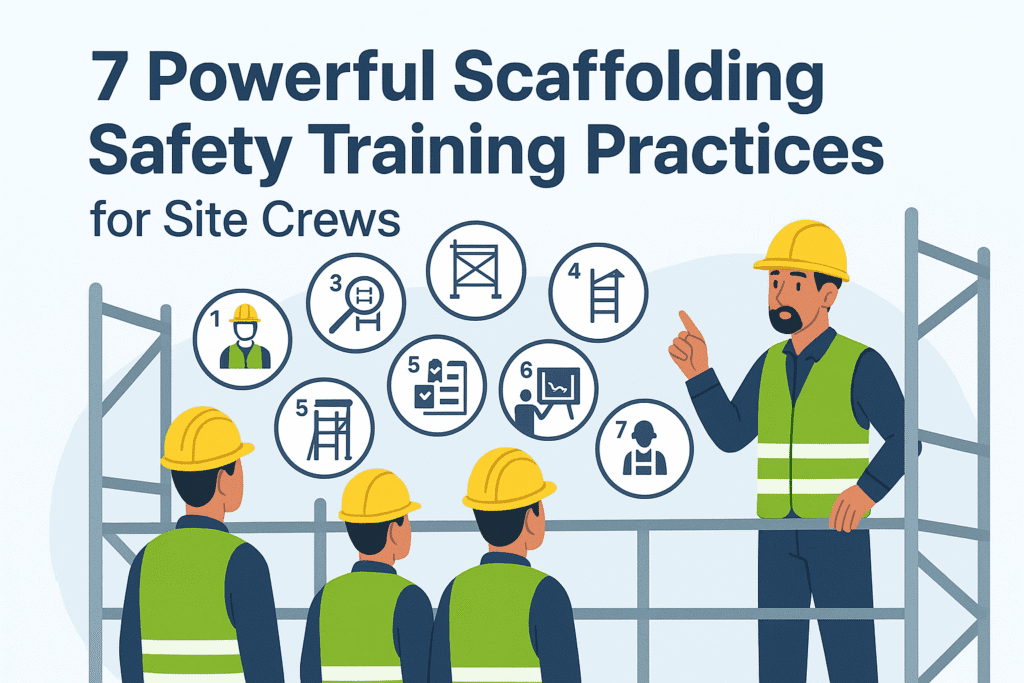
7 Powerful Scaffolding Safety Training Practices for Site Crews
Scaffolding provides essential access for construction, maintenance, and repair tasks — but it’s also a high-risk activity. Falls from scaffolds remain one of the leading causes of injuries and fatalities in the construction industry. Comprehensive scaffolding safety training helps site crews build, inspect, and use scaffolds safely while complying with regulations.
This article outlines 7 Powerful Scaffolding Safety Training Practices every site crew should follow to reduce accidents and improve productivity.
Why Scaffolding Safety Training Matters
- Fall Prevention: Proper training drastically reduces falls and injuries.
- Regulatory Compliance: OSHA 29 CFR 1926 Subpart L and similar standards require scaffold safety training.
- Efficiency: Well-trained crews erect and dismantle scaffolds faster and more safely.
- Safety Culture: Training shows management values worker well-being.
Practice 1: Understand Types of Scaffolds and Their Components
Site crews must know the basics:
- Different scaffold systems: supported, suspended, mobile, cantilever.
- Components: standards, ledgers, transoms, planks, guardrails, toe boards.
- Load ratings and design capacities.
Example: A team identifies the difference between a mobile scaffold and a supported frame scaffold and uses each correctly.
Training Tip: Use diagrams or actual equipment to teach scaffold anatomy.
Practice 2: Conduct Pre-Use Inspections
Scaffolds must be inspected before each shift:
- Check for damaged or missing components.
- Verify planks are secure and level.
- Ensure guardrails, toe boards, and access ladders are installed.
- Confirm scaffold is erected on stable ground with base plates.
Example: A supervisor checks the scaffold tag before allowing workers to climb.
Training Tip: Provide a simple inspection checklist to all crews.
Practice 3: Erect and Dismantle Scaffolds Safely
Only trained and competent persons should build or dismantle scaffolds:
- Follow manufacturer instructions and design specifications.
- Use fall protection when erecting scaffolds above a certain height.
- Keep materials and tools organized to prevent falling objects.
- Never remove critical components prematurely.
Example: Workers install guardrails as they go rather than waiting until the scaffold is complete.
Training Tip: Include hands-on erection and dismantling exercises during training.
Practice 4: Use Proper Access and Egress
Unsafe climbing causes many injuries:
- Provide ladders, stair towers, or built-in access points.
- Maintain three points of contact when climbing.
- Never climb cross-braces or scaffold frames.
- Keep access clear of debris and obstructions.
Example: Workers use a designated stair tower instead of climbing scaffold frames.
Training Tip: Show videos of correct vs. incorrect access during toolbox talks.
Practice 5: Follow Load Limits and Material Handling Rules
Overloading scaffolds leads to collapse:
- Adhere to the scaffold’s rated capacity.
- Distribute loads evenly and avoid concentrated loads.
- Store materials neatly to prevent tripping or falling objects.
Example: A crew keeps only necessary tools and materials on the platform to reduce weight.
Training Tip: Demonstrate how to calculate load capacities in training sessions.
Practice 6: Use Fall Protection and Guardrails
Even with guardrails, fall protection may be required:
- Install guardrails at proper heights on all open sides.
- Use personal fall arrest systems when necessary.
- Keep platforms fully planked and clear of gaps.
Example: Workers on a suspended scaffold wear harnesses connected to independent lifelines.
Training Tip: Include a hands-on harness inspection and fitting exercise.
Practice 7: Refresh Training and Reinforce Safety Regularly
Scaffolding safety is not a one-time lesson:
- Provide refresher training annually or when new scaffold types are introduced.
- Conduct regular toolbox talks on scaffold hazards.
- Review incidents and near-misses to improve practices.
Example: After a minor incident, the crew holds an on-site refresher on securing planks.
Training Tip: Use quizzes, demonstrations, or peer mentoring to keep knowledge fresh.
Implementing Scaffolding Safety Training for Site Crews
To make these practices effective:
- Hands-On Training: Practice erecting, inspecting, and using scaffolds on-site.
- Visual Aids: Use photos, diagrams, and videos to show correct practices.
- Assess Competency: Evaluate workers with practical tests.
- Record Training: Maintain logs for compliance audits.
Benefits of 7 Powerful Scaffolding Safety Training Practices
- Reduced Falls and Injuries: Protects lives and reduces lost-time accidents.
- Compliance: Meets OSHA/NEBOSH/ISO scaffold safety standards.
- Improved Efficiency: Crews work faster and safer.
- Stronger Safety Culture: Workers feel valued and confident.
Key Takeaways
Scaffolding is essential but risky. By teaching these 7 Powerful Scaffolding Safety Training Practices, you equip site crews to build, use, and dismantle scaffolds safely and efficiently.
Suggested Internal & External Links
- External: OSHA Scaffolding
- Internal: 10 Must-Know Working at Height Safety Training Rules
- 7 Essential Machine Guarding Training Practices for Operators
- 5-Step Lockout Tagout Safety Training Guide for Maintenance Teams
- 10 Powerful Electrical Safety Training Tips to Prevent Shocks
- 12 Ultimate Fire Prevention Training Tips for Workers
Frequently Asked Questions
1. Why is scaffolding safety training important for site crews?
It teaches them to erect, inspect, and use scaffolds safely, reducing the risk of falls, collapses, and injuries.
2. How often should scaffolding safety training be refreshed?
At least annually or whenever new scaffold systems or procedures are introduced.
3. Who should erect or dismantle scaffolds?
Only trained and competent persons under the supervision of a qualified person.
4. What is the most important rule for working on scaffolds?
Never overload scaffolds, always use proper access, and keep guardrails or fall protection in place.
5. How can companies make scaffolding safety training engaging?
Include hands-on demonstrations, videos of best practices, case studies, and interactive quizzes.